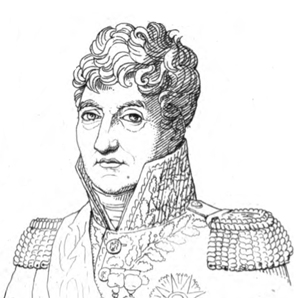General Honoré-Théodore-Maxime Gazan

Born: October 29, 1765
Place of Birth: Grasse, Alpes-Maritimes, France
Died: April 9, 1845
Place of Death: Grasse, France
Arc de Triomphe: GAZAN on the south pillar
Pronunciation:
A career soldier, Honoré-Théodore-Maxime Gazan joined a regiment of cannoniers of the coast guard of Antibes as a sous-lieutenant in 1780. When the Revolution came along, in December of 1789 he joined the National Guard of Grasse as a lieutenant. The next year Gazan was promoted to capitaine, and then in September of 1791 he became a lieutenant colonel in the 2nd Battalion of Volunteers of Var. Gazan went on to join the Army of the Rhine and in 1794 was he promoted to chef de bataillon in May. Two months later he received another promotion, this time to chef de brigade, and afterwards he fought at Trippstadt.
In 1795 Gazan served with the Army of the Rhine and Moselle, and in the summer of 1796 he fought at Kuppenheim, Ettlingen, Neresheim , and Geisenfeld. In November of that year he fought at Kehl where he was wounded by a shot. Gazan spent the next few years serving with different armies, and in 1799 he was promoted to général de brigade. Taking command of the 2nd Brigade of Oudinot's division, he fought at Frauenfeld. In September he commanded the advance guard at the Battle of Zurich where he seized the suburbs and was promoted to général de division on the battlefield. In October Gazan commanded the 4th Division of the Army of Switzerland and with them he seized Winterthur and Constance.
In December of 1799 General Gazan transferred to the Army of Italy where he took command of the 3rd Division. While in Italy he served against the revolts of the valley of Fontana Buona, and then he took part in the defense of Genoa under General Soult. While defending Genoa, Gazan seized Acqua Santa, de Verreria, and de Sassello, but when trying to take the redoubt of Coronata on May 2nd he was wounded in the head. Once back in action, he took part in the attack on Monte-Cretto on May 13th. After the siege was over, in July Gazan took command of the 1st Division of the Army of Italy. That December he fought at Vola, Pozzolo, and Bassano.
In September of 1801, Gazan requested to be put on non-activity and this request was granted. A year later he returned to take command of a subdivision of the 27th military division. In 1805 he was designated for the Army of the Coast of the Ocean, and when war broke out he took command of the 2nd Division of Marshal Lannes' V Corps. During that campaign, in October he was detached from Lannes' corps and attached to Mortier's corps, fighting at Dürenstein in November. Afterwards Gazan's division rejoined V Corps, and the next year he fought at Jena and Pultusk . In 1807 Gazan and his men served at Ostrolenka.
In 1808 Gazan's division was transferred with V Corps to the Army of Spain. That year he was also named Count of La Peyrière. In 1809 he served during the siege of Saragossa, and then in 1810 he served in Andalusia, notably winning at El Ronquillo in March. That November he was named chief of staff to the Army of the South. Gazan continued fighting in 1811, for in January he won at Villanova de Castillejos, and then over the following months he was wounded at the siege of Badajoz and then wounded again at Albuera .
In 1813, Gazan took command of the Army of Andalusia in January, and then temporarily assumed command of the Army of the South in Spain. After the loss of the Battle of Vitoria , his wife was captured by the British Army, but Wellington had her escorted back to Gazan in her own carriage.1 As the French fell back, Gazan was named chief of staff of the Army of the Pyrenees under Marshal Soult.
After Napoleon's abdication in 1814, Gazan was well treated by the Bourbons, being rewarded as a Knight of Saint Louis and receiving the Grand Cross of the Legion of Honor. As Napoleon marched back to Paris, Gazan maintained loyalty to the Bourbons but then fled Grasse as Napoleon approached. Back in power, Napoleon put Gazan in charge of the National Guard of the 1st military division and the defense of the Somme but did not use him actively during the Hundred Days.
After Napoleon's second abdication, Gazan was selected to replace General Maison on the council of war to judge Marshal Ney. Ultimately the council of war found itself incompetent and the trial was moved to the Chamber of Peers.2
Notes
- Philip J. Haythornthwaite, Who Was Who in the Napoleonic Wars, (London: Arms & Armour, 1998), 129.
- Henri Welschinger, Le Maréchal Ney: 1815, (Paris: Librairie Plon, 1893), 147.
Bibliography
- Haythornthwaite, Philip J. Who Was Who in the Napoleonic Wars. London: Arms & Armour, 1998.
- Six, Georges. Dictionnaire Biographique des Généraux & Amiraux Français de la Révolution et de l'Empire (1792-1814). 2 vols. Paris: Gaston Saffroy, 2003.
Updated December 2014
© Nathan D. Jensen